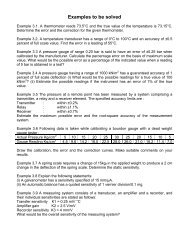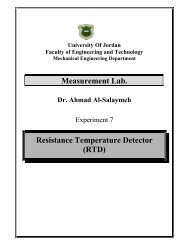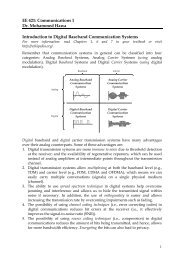Simulation of Third Generation CDMA Systems - Virginia Tech
Simulation of Third Generation CDMA Systems - Virginia Tech
Simulation of Third Generation CDMA Systems - Virginia Tech
You also want an ePaper? Increase the reach of your titles
YUMPU automatically turns print PDFs into web optimized ePapers that Google loves.
Dt<strong>of</strong>fset = 2 (3.15)cHere c is the velocity <strong>of</strong> light. If we assume a cell radius <strong>of</strong> 20 km we get2t <strong>of</strong>fset= 20 10831034 -= 3 10 4 Sec (3.16)Since we have a chip rate <strong>of</strong> 3.84 Mcps, the maximum <strong>of</strong>fset corresponds to43-4 610 384 . 10 = 512 chips.These asynchronous transmitted frames arrive at the base station via differentmultipath channels and constitute MAI. In this simulator we assume that we have perfectpower control (i.e. all the users transmit at equal power and the received signal at the basestation for all the users are at the same average power level).3.2.3 Time Varying ChannelThe chip rate <strong>of</strong> the W<strong>CDMA</strong> signal is 3.84 Mcps. This narrow pulse width meansthat the multipaths would be resolved most <strong>of</strong> the time and the transmitted signal willencounter frequency selective fading. Three different types <strong>of</strong> multipath channel wereemployed in the simulator. They are1. Indoor channel2. Indoor to Outdoor channel3. Vehicular A Outdoor channelHowever, different channel models like COST 207 [16] or Simple Two Ray Model [17] canalso be easily incorporated with the simulator.Each <strong>of</strong> the three channels employed at the simulator corresponds to differentenvironment as their names suggest. The multipath pr<strong>of</strong>iles <strong>of</strong> the channels shown in the31
















